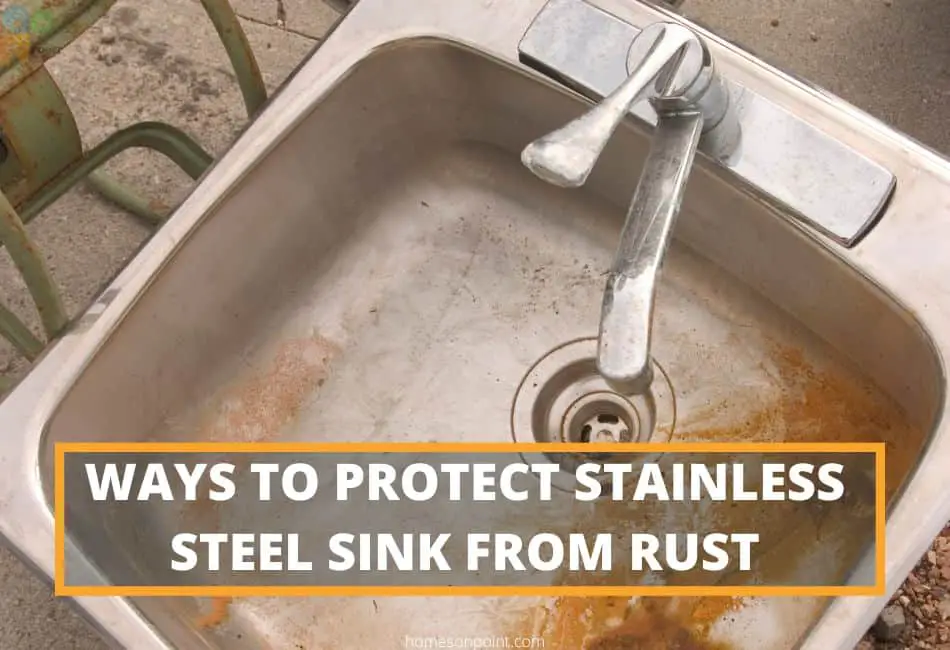Your stainless steel sink is one of the most important pieces of kitchen equipment that you own. Not only does it make washing dishes a breeze, but it also adds a touch of luxury to your kitchen décor. However, if not properly taken care of, stainless steel sinks can rust and corrode over time. In this article, we will discuss some practical ways to protect your stainless steel sink from rust and corrosion.
Most of the time people are misled by the term stainless steel. They think that this type of steel does not corrode or rust. Unfortunately, this is not the case. Stainless steel can and will rust if not properly taken care of. It is, therefore, necessary to understand some basics about stainless steel to keep your sink looking good all the time.
About Stainless Steel And Stainless Steel Sinks
There are three main types of stainless steel: austenitic, ferritic, and martensitic. The most common type of stainless steel is austenitic stainless steel, which is used in the majority of kitchen sinks on the market today. This type of stainless steel is made of chromium and nickel. It also contains other elements such as molybdenum, copper, and carbon. Austenitic stainless steel is non-magnetic and has a higher resistance to corrosion than other types of stainless steel.
The added chromium in stainless steel creates a thin layer of chromium oxide on the surface of the metal. This chromium oxide layer is what gives stainless steel its corrosion-resistant properties. When scrubbed away lightly, it self-repairs and creates an invisible barrier that protects the stainless steel underneath.
For stainless steel to rust, the chromium oxide layer must be damaged or removed. If this chromium oxide layer is damaged or removed completely, the stainless steel underneath will be exposed to oxygen and moisture, which can cause it to rust.
Causes Of Rust In Stainless Steel Sinks
There are a few things that can damage the chromium oxide layer on stainless steel. They include:
1. Exposure To Chlorine
Chlorine is a common ingredient in many household cleaning products. When stainless steel is exposed to chlorine, the chromium oxide layer is slowly eroded, exposing the underlying metal to oxygen and moisture. Your stainless steel sink can only tolerate a few ppm (parts per million) of chlorine before it begins to corrode. Beyond that level, your sink will start pitting, staining, and rusting.
2. Exposure To Salt
Salt is another common household ingredient that can damage stainless steel. When salt comes into contact with the metal, it creates an electrolytic reaction that accelerates the process of corrosion. It attacks the chromium oxide layer, causing it to break down and exposing the underlying metal to oxygen and moisture. As a result, stainless steel objects that are regularly exposed to salt water or salt air are at a higher risk of rusting.
3. Metal Utilities Left In The Sink
Sometimes the rust you see in your sink will most likely not be from the sink itself but residue from other sources in the sink such as metal cookware. The most common culprit is utensils left to dry in the stainless steel sink. Kitchen items such as baking sheets and cast iron pots will oxidize when left in water and will leave a brownish or reddish film on stainless steel.
4. Wet Sponge Or Towel Left In Sink
Leaving a wet sponge or towel in the stainless steel sink is never a good idea. It is a common practice for people to leave a wet sponge or towel to dry on the sink. If your stainless steel sink is exposed to damp environments for prolonged periods, it can fuel the development of rust.
5. Soap Dispensers
Soap dispensers are another common stainless steel sink accessory that can cause rust. Many people house dish soaps in metal soap dispensers and some sinks even have built-in soap dispensers. Soap and water can find their way around and under the soap dispenser, making contact with the stainless steel sink. If not cleaned immediately, the metal soap dispenser will begin to rust and leave rust, and eventually, the stainless sink will as well.
6. Iron In Water
When water contains a high level of iron it can cause stainless steel to rust. When water molecules come into contact with iron, they cause the iron to oxidize. This process creates rust, which is a red or brown powdery substance.
7. Steel Wool Pads
Steel wool is made of tiny pieces of metal that can easily scratch the surface of stainless steel. Once the stainless steel is scratched, it becomes more susceptible to rusting because the chromium oxide layer has been damaged.
Additionally, steel wool pads break apart when used for scrubbing and the fine metal fibers can become lodged in the finish of the stainless steel. Over time, the metal fibers will begin to rust giving you the appearance of rust spots on stainless steel.
How To Prevent Rust On Stainless Steel Sinks
Now that you know some of the causes of rust on stainless steel sinks, here are a few tips on how to prevent it.
1. Avoid Chlorine Cleaners
Avoid cleaning products that contain chlorine. Chlorine can remove the protective layer from stainless steel, making it more susceptible to rusting. If you happen to use a product that contains chlorine, be sure to rinse the stainless steel sink thoroughly with clean water afterward.
2. Wipe And Dry Immediately
Wipe up any water spills immediately and dry the stainless steel sink with a soft towel after each use. Allowing water to sit on stainless steel for too long can cause rusting especially when the water contains so much iron.
3. Avoid Using Steel Wool Pads
Avoid using steel wool pads or other abrasive scrubbers on stainless steel sink. Instead, use a soft cloth or sponge. Steel wool pads will scratch the surface of the stainless steel sink and which can lead to rusting over time. They will also leave behind residue that will rust in your sink.
4. Store Accessories In A Dry Place
Store stainless steel sink accessories such as soap dispensers and sponges in a dry place. Do not leave them sitting in the stainless steel sink as they can cause rusting. Metal dish strainers for instance can leave rust marks if left in the sink.
5. Don’t Use Oven Cleaners
Oven cleaners are harsh chemicals that can damage the stainless steel sink. Though this cleaning product is very effective for removing stubborn stains and grime in the oven, it doesn’t make it safe to use on stainless steel. It will destroy the finish of the sink, exposing it to rust conditions.
6. Never Put Metal Cookware In Your Sink To Dry
If you must dry your metal cookware, don’t do it in your stainless steel sink or any sink for that matter. Neither should you leave metal objects in your sink to soak. When moisture comes into contact with metal cookware made with materials like cast iron, it will begin to rust leaving behind rust stains in your sink.
7. Never Leave Wet Or Damp Items In The Sink
Always try to achieve dryness in your stainless steel sink when not in use. Leaving damp items such as wet towels or sponges in the sink is the opposite of you trying to protect your sink from rust as it will only hasten the rusting process. If you’re not using your stainless steel sink, make sure to keep it dry until next time.
8. Regular Cleaning
Cleaning your stainless steel sink regularly will help to prevent rust. Use a quality stainless steel cleaner that is designed for use on stainless steel sinks. You can use normal dish soap and warm water to clean your stainless steel. Once you have a regular cleaning schedule, you should be fine.
Ideally, you should thoroughly clean your sink after each use. This is particularly important if you leave close to the beach where the sea breeze has a lot of salt which is corrosive in nature.
9. Do Not Use Your Sink As A Cutting Board
Stainless steel sinks are not cutting boards. If you must cut something, use a cutting board and not your sink. Cutting on stainless steel will damage the finish and over time it will become dull and susceptible to rusting.
How To Remove Rust From Stainless Steel Sinks
If you experience rusting on your stainless steel sink, you can use a mild abrasive such as baking soda to remove the rust and restore your sink back to its original condition.
- Make a paste using equal parts of baking soda and water.
- Apply the paste to the rusted area with a non-abrasive cloth and let it sit for a few minutes
- Rub the baking soda with a non-abrasive cloth in the direction of the grain with a little bit of elbow grease.
- Rinse the cleaner from the sink thoroughly
- Use a soft towel to dry the stainless steel sink.
Final Thoughts
Stainless steel sinks are a very popular choice for the kitchen and bathroom. They’re easy to maintain and care for but they can still rust if not properly taken care of. Use these tips to protect your stainless steel sink from rusting and enjoy it for many years to come. Always remember, they are called stainless but that doesn’t mean they can’t be stained at all. Thanks for reading!
I hope you found this article helpful.

